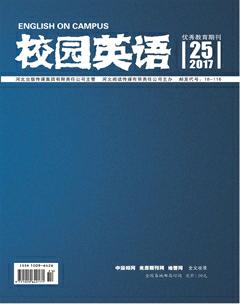Application of Brainstorming in English Teaching and Learning
王智悦
Brainstorming is a group and creative method to find a conclusion for a specific problem by gathering ideas of all members. People are required to think and propose a series of methods related to the problem within a certain time, which provides people with various ways to see a problem from different perspectives. Combined with English study, this method integrates what we have learnt and new knowledge together and one may find it relatively easy to learn English with the help of information shared by all members.
1. Models of brainstorming
(1) Stimulating—teachers assign tasks according to certain contents prepared before so that students mind can be stimulated.
(2) Retaining—students gather materials from the stimulated knowledge schema in order to pave the way for storming.
(3) Storming—students are encouraged to provide as much information as possible that is gathered before within a particular time.
(4) Checking—time for one student cannot be much too long and it is sometimes accepted to call a halt when students still have something else to convey.
(5) Inspiring—students should be encouraged, guided and inspired when they have difficulty in making themselves clear.
2. Teaching principles of brainstorming
(1) Teachers roles are dynamic
Teachers play different roles in different stages in this interactive teaching method. In the first stage, teachers are designers—design the forms and tasks of activities according to characteristics of students and contents of teaching materials. In the second stage, teachers are organizers of activities—instruct students in the process of activities. In the third stage, teachers are promoters in teaching—give students necessary help when they have difficulties. In the fourth stage, teachers are evaluators of activities—give evaluations and put forward some suggestions.
(2) Cooperate and share information with others
The cooperation here has two meanings. First, teachers and students share information with each other in the process of information transmission. Second, they help each other in the process of information processing. Teachers should encourage and inspire students to put forward their own understanding toward certain problems and thus, ones image can be enriched by others viewpoint.
(3) Create a free academic atmosphere
A free academic atmosphere should be created so as to promote learning. For example, encourage students as much as possible to express themselves and do not interrupt their speaking; opinions of all students should be respected; give more positive evaluation to students, etc.
3. Application of brainstorming
(1) Vocabulary
When new words are introduced, teachers can inspire students to remember related words and phrases they have learnt before. Students can be grouped to share what they have borne in mind within the group, and compete with other groups as to which one has found more. And it is also accepted that they find information through Internet, so that they can learn more words.
(2) Lead-in
Before teachers begin their class, they can set a question related to the text and give students several minutes to think about it before they share it with the whole class. Students can say anything they are interested related to the topic and thus students can understand it from different perspectives.
(3) Oral English
Many students are afraid of speaking English in public because they are not able to express themselves clearly with words in their mind. Therefore, before discussion, teachers ought to guide students to think of all the words related to the topic, which will set the stage for their discussion and students will not be hindered by limited vocabulary.
(4) Writing
In the process of traditional teaching, it is always teachers that assign a topic and students write based on it. Students always have no idea what they can write to support their idea. So before they start to write, teachers are supposed to guide students to share information by cooperation so that every student will have something to write.
Brainstorming can be adopted throughout the teaching of English, by which English class can be much more active and students will be more interested in it. One important point is that there must be a balance among active students and silent ones. Opportunities should be given to all of them to express themselves and make sure they all have their own understanding instead of following others ideas.
References:
[1]何靈敏.试论“头脑风暴法”在大学英语教学中的运用[J].科教文汇旬刊,2009(20):159-160.
[2]张慧琴,杨惠丽,郭平建.“头脑风暴法”在英语写作教学中的应用[J].教育理论与实践,2011(27):57-59.

